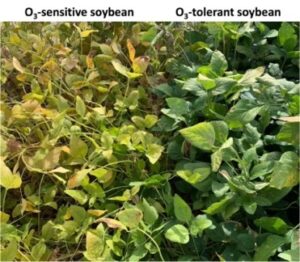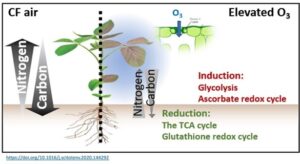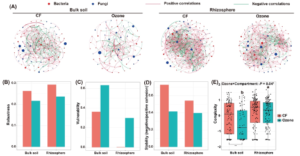Ripley Tisdale

USDA Assistant Professor
Plant Physiologist
USDA-ARS Plant Science Research Building 3127 Ligon St. Raleigh, NC 27607
ripley.tisdale@usda.gov WebsiteBio
Research rationale:
Global warming is attributed to elevated heat-trapping greenhouses gases. So, greenhouse gases and rising temperatures often co-occur and degrade crop health and productivity. Tropospheric ozone (O3) is one of the most harmful greenhouse gases to crop health and yield, as well as agricultural ecosystems. However, how ozone interacts with other environmental stresses and greenhouse gases is not well understood. While the race is on to mitigate global greenhouse gas emissions, there is an accompanying urgency to enhance knowledge of plant responses to elevated ozone and co-occurring rising temperatures. We hope our research contributions can come up with direct solutions to tackle future air pollution and climate threats to food security.
Research approach:
- Identifying climate-resilient crops
 To assess ozone and heat resilience, we further test plants with separated and combined elevated ozone and heat using the Field-based Climate Change System and characterize stress-resilient traits and crop yield.
To assess ozone and heat resilience, we further test plants with separated and combined elevated ozone and heat using the Field-based Climate Change System and characterize stress-resilient traits and crop yield.
- Determining plant molecular, biochemical, and physiological responses under environmental stresses
 To understand the molecular and biochemical regulations that account for physiological responses under greenhouse gas emissions and global warming, we have applied “multi-omic” approaches as well as physiological measurements to reveal this knowledge gap.
To understand the molecular and biochemical regulations that account for physiological responses under greenhouse gas emissions and global warming, we have applied “multi-omic” approaches as well as physiological measurements to reveal this knowledge gap.
- Investigating interactions of plant roots and soil microbes
 Evidence shows environmental stresses, including air pollution and rising temperatures, often rapidly impact root growth and interactions between roots and soil microbes, which essentially affects plant performance. However, impacts of these stresses on roots have been overlooked. We put special emphasis on characterizing root molecular and biochemical responses to climate change and on identifying soil microbial network dynamics associated with carbon and nitrogen allocation in the agricultural eco-system.
Evidence shows environmental stresses, including air pollution and rising temperatures, often rapidly impact root growth and interactions between roots and soil microbes, which essentially affects plant performance. However, impacts of these stresses on roots have been overlooked. We put special emphasis on characterizing root molecular and biochemical responses to climate change and on identifying soil microbial network dynamics associated with carbon and nitrogen allocation in the agricultural eco-system.
Publication:
- Zhang, K., Zentella, R., Burkey, K. O., Liao, H. L., & Tisdale, R. H. (2023). Microbial community dynamics responding to nutrient allocation associated with soybean cultivar ‘Jake’ozone adaptation. Science of The Total Environment, 864, 161008.
- Zentella, R., Burkey, K. O., & Tisdale, R. H. (2023). Impact of tropospheric ozone on root proteomes of two soybean genotypes with contrasting sensitivity to ozone. Environmental and Experimental Botany, 208, 105269.
- Livingston, D., Tuong, T., Tisdale, R., & Zobel, R. (2022). Visualising the effect of freezing on the vascular system of wheat in three dimensions by in‐block imaging of dye‐infiltrated plants. Journal of Microscopy, 286(3), 252-262.
- Tisdale, R. H., Zobel, R. W., & Burkey, K. O. (2021). Tropospheric ozone rapidly decreases root growth by altering carbon metabolism and detoxification capability in growing soybean roots. Science of the Total Environment, 766, 144292.
- Tisdale, R. H., Zentella, R., & Burkey, K. O. (2021). Impact of elevated ozone on yield and carbon-nitrogen content in soybean cultivar ‘Jake’. Plant Science, 306, 110855.
- Livingston III, D. P., Bertrand, A., Wisniewski, M., Tisdale, R., Tuong, T., Gusta, L. V., & Artlip, T. (2021). Factors contributing to ice nucleation and sequential freezing of leaves in wheat. Planta, 253(6), 124.
- Burkey, K., Tisdale, R., Zobel, R., Ray, S., & Pursley, W. (2020). Interactive effects of elevated ozone and temperature on growth and yield of soybean (Glycine max (L.) Merr.) under field conditions. Agronomy, 10(11), 1803.